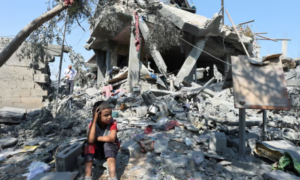I’ll be helping to clear unexploded bombs in Gaza, my home. But I dread what I will find there

The aftermath of an Israeli strike on a house in Nuseirat refugee camp, Gaza
Haniya Albaioumy writes in The Guardian on 11 July 2024:
Amid the many horrors unfolding in my Gaza homeland, there is one that, for now, is hidden but threatens to blight hopes for recovery long after the bombs have stopped falling.
Gaza is one of the most densely populated places on Earth. And, tragically, it could now be one of the most densely contaminated in terms of unexploded munitions. This is a deadly legacy that will claim lives and hamper attempts at reconstruction for years to come.
I know this, because in my role as an emergency response manager for Mines Advisory Group (MAG), I will be one of those tasked with assisting colleagues as they clear the unexploded bombs left behind. Our daily work requires sifting through the rubble and detritus of war in heavy body armour, trying to map a way forward from the destruction and devastation.
I am from Gaza City, so I have a special personal interest in returning my home to some kind of normality: a place where children can play at the seaside and their parents can go about their normal lives without fear of an unexploded bomb going off nearby.
Hundreds of thousands of missiles, grenades, shells, mortars and other weapons have been expended in Gaza since 7 October. A significant proportion of those weapons will have failed to explode and could be buried, lodged in the rubble or lying on the surface. Landmine and explosive ordnance experts like us have to go into war zones after the dust has settled and find each and every one of these potentially lethal items, making them safe. In Gaza, the painstaking and dangerous reconstruction operation could, according to the UN Development Programme, cost some $40bn (£32bn) and take more than a decade to complete.
